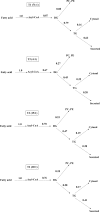In vivo monitoring of hepatic glycolipid distribution of n-6 ∕ n-3 in jugular-vein-cannulated rats as a nutritional research model for monogastric animal
- PMID: 31807655
- PMCID: PMC6852779
- DOI: 10.5194/aab-62-437-2019
In vivo monitoring of hepatic glycolipid distribution of n-6 ∕ n-3 in jugular-vein-cannulated rats as a nutritional research model for monogastric animal
Abstract
The metabolic distribution via blood from liver of glycerolipids by omega-6 to omega-3 fatty acid ( -6 -3) ratio in monogastric animal nutrition is very important. In vivo monitoring technique using jugular-vein-cannulated rats as a nutritional model for monogastric animal can yield important insights into animal nutrition. This study was conducted to determine the effect of different -6 -3 ratios ( , , , ) on metabolic distribution of glycerolipids newly synthesized and secreted in the liver of the rats and explore the mechanism involved. Regarding released from oxidation of glycerolipid metabolism, it was the highest (22.5 %) in groups with a -6 -3 ratio of ( ). The control group showed the highest total glycerolipid level, followed by the , , and groups in order ( ). When secreted triacylglycerol level of each group was compared with that of the control group, the , , and groups were decreased by 36.3 %, 20.9 %, and 13.3 %, respectively ( ). Regarding the distribution of phospholipid against total glycerolipid compared to the control group, the , , and groups were 1.38, 1.29, and 1.17 times higher, respectively ( ). In the comparison of emission against total glycerolipid compared with the control group, the , , and groups were 1.61, 1.52, and 1.29 times higher, respectively ( ). These results demonstrate that a dietary -6 -3 fatty acid ratio of could significantly decrease harmful lipid levels in the blood by controlling the mechanism of metabolic distribution via blood from triglyceride and phospholipid newly synthesized in the liver of cannulated rat.
Copyright: © 2019 Sang-O. Park and Victor A. Zammit.
Conflict of interest statement
The authors declare that they have no conflict of interest.
Figures
Similar articles
-
Molecular Mechanism for Hepatic Glycerolipid Partitioning of n-6/n-3 Fatty Acid Ratio in an Obese Animal Biomodels.Int J Mol Sci. 2023 Jan 13;24(2):1576. doi: 10.3390/ijms24021576. Int J Mol Sci. 2023. PMID: 36675096 Free PMC article.
-
In Vivo Monitoring of Glycerolipid Metabolism in Animal Nutrition Biomodel-Fed Smart-Farm Eggs.Foods. 2024 Feb 27;13(5):722. doi: 10.3390/foods13050722. Foods. 2024. PMID: 38472835 Free PMC article.
-
Monitoring of changes in hepatic fatty acid and glycerolipid metabolism during the starved-to-fed transition in vivo. Studies on awake, unrestrained rats.Biochem J. 1993 Jan 1;289 ( Pt 1)(Pt 1):49-55. doi: 10.1042/bj2890049. Biochem J. 1993. PMID: 8424771 Free PMC article.
-
Cooperation of liver cells in health and disease.Adv Anat Embryol Cell Biol. 2001;161:III-XIII, 1-151. doi: 10.1007/978-3-642-56553-3. Adv Anat Embryol Cell Biol. 2001. PMID: 11729749 Review.
-
The role of insulin in the control of hepatic fatty acid and glycerolipid metabolism assessed by studies in vivo.Braz J Med Biol Res. 1995 Oct;28(10):1027-31. Braz J Med Biol Res. 1995. PMID: 8634673 Review.
Cited by
-
Molecular Mechanism for Hepatic Glycerolipid Partitioning of n-6/n-3 Fatty Acid Ratio in an Obese Animal Biomodels.Int J Mol Sci. 2023 Jan 13;24(2):1576. doi: 10.3390/ijms24021576. Int J Mol Sci. 2023. PMID: 36675096 Free PMC article.
References
-
- Bhardwaj K, Verma N, Trivedi R, Bhardwaj S, Shukla N. Significance of ratio of omega-3 and omega-6 in human health with special reference to flaxseed oil. Int J Biol Chem. 2016;10:1–6.
-
- Brugger LE, Beldi G, Beck M, Porta F, Bracht H, Candinas D, Takala J, Jakob SM. Splanchnic vasoregulation after major abdominal surgery in pigs. World J Surg. 2010;34:2057–2063. - PubMed
-
- Bucher HC, Hengstler P, Schindler C, Meier G. -3 polyunsaturated fatty acids in coronary heart disease: a meta-analysis of randomized controlled trials . Am J Med. 2002;112:298–304. - PubMed
-
- Cao J, Hawkins E, Brozinick J. A predominant role of Acyl CoA: monoacylglycerol acyltransferase-2 in dietary fat absorption implicated by tissue distribution, subcellular localization, and up-regulation by high fat diet. J Biol Chem. 2004;279:18878–18886. - PubMed
LinkOut - more resources
Full Text Sources

